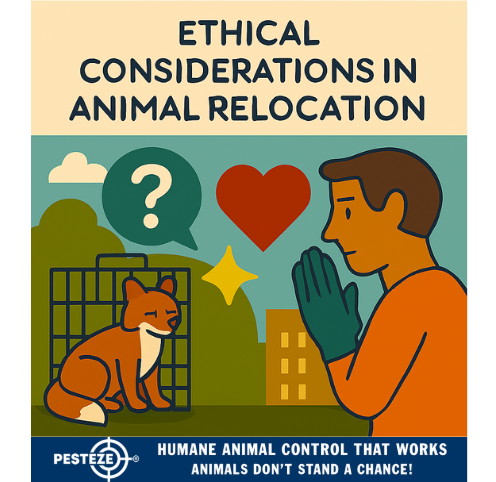ETHICAL CONSIDERATIONS IN ANIMAL RELOCATION

ETHICAL CONSIDERATIONS IN ANIMAL RELOCATION
SUMMARY
Animal relocation is often viewed as a humane solution to wildlife conflicts, but it raises complex ethical questions. From the welfare of individual animals to the impact on ecosystems, relocation must be approached with care, legality, and long-term thinking. This guide explores the ethical principles behind responsible relocation, highlighting when it’s appropriate, what risks it poses, and why alternatives may be more effective. Understanding these considerations helps protect both animals and the environments they inhabit.
FEATURES
-
Animal Welfare First: Relocation should minimize stress, injury, and mortality for the animal involved.
-
Ecological Impact Matters: Introducing animals to new areas can disrupt local wildlife and spread disease.
-
Legal Compliance Is Essential: Most regions require permits and professional oversight for relocation.
-
Habitat Suitability Must Be Assessed: Animals should only be released into environments that support their survival.
-
Long-Term Effectiveness Should Be Evaluated: Relocation must solve the root problem, not shift it elsewhere.
-
Alternatives May Be Preferable: Prevention, exclusion, and coexistence strategies often offer better outcomes.
GUIDE DESCRIPTION
Relocating wild animals may seem like a compassionate response to human-wildlife conflict, but it involves a web of ethical, ecological, and legal considerations. While the intention is often to spare the animal from harm, relocation can unintentionally cause suffering or create new problems.
The first ethical priority is animal welfare. Relocation can be traumatic—animals may experience stress during capture, transport, and release. Many do not survive the transition due to unfamiliar terrain, lack of food, or exposure to predators.
Ecological consequences are another major concern. Moving animals to new areas can disrupt local ecosystems, introduce diseases, and create competition with native species. Conservation biologists emphasize that relocation should never compromise biodiversity or habitat integrity.
Legal regulations are in place to protect both animals and communities. In most states, relocating wildlife without a permit is illegal. Professional wildlife control operators are trained to assess risks and follow humane protocols.
Habitat suitability is critical. Animals must be released into areas that match their natural needs—adequate shelter, food, and safety. Releasing them into unsuitable environments can lead to starvation, conflict, or death.
Relocation should also be evaluated for long-term effectiveness. If the root cause—such as unsecured trash or shelter access—isn’t addressed, another animal may simply take its place. Ethical relocation considers whether the solution truly resolves the issue.
In many cases, alternatives like exclusion barriers, deterrents, and public education offer more sustainable results. These methods reduce conflict without displacing animals or risking ecological harm.
By understanding the ethical dimensions of animal relocation, communities can make informed decisions that prioritize compassion, legality, and environmental stewardship.
- Amy Chang


Comments 0